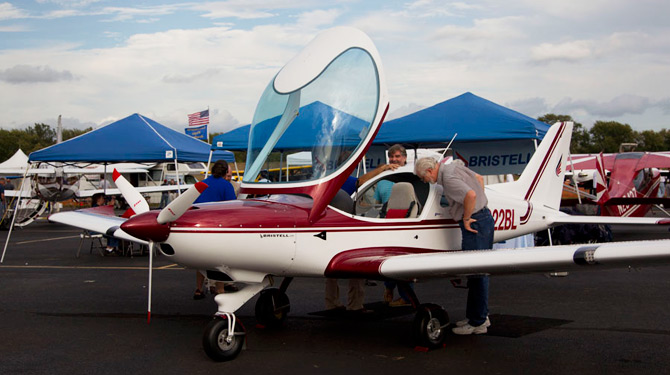
Liberty Sport Aviation unveiled a new light sport airplane, the Bristell, at AOPA Aviation Summit on Sept. 22. The all-metal, low-wing airplane, designed by Milan Bristela—who was behind the Evektor SportStar and PiperSport (now SportCruiser) LSAs—is manufactured by BRM Aero in the Czech Republic. Powered by a 100-horsepower Rotax 912 ULS engine, the airplane cruises as fast as 117 knots; its fuel capacity of 34.3 gallons provides endurance of up to eight hours.
An example is on display at Airportfest, at Hartford-Brainard Airport, through Sept. 24. “It’s a great flyer,” said Barry Pruitt, a partner in Liberty Sport Aviation who flew the airplane 2.5 hours from Lancaster, Pa., to Hartford on Wednesday. “It performs great. It’s very comfortable even after a long period of time.”
The Bristell represents a fifth-generation design for Bristela, who began working in aviation 20 years ago, initially in fatigue analysis and testing. “It gave me much experience about the structure,” he said. “The whole airplane is designed with CATIA software. Even the smallest, most basic part is done with CNC machines.” Should repairs ever be needed, they will be very easy, he said. “It’s just replacement of the damaged parts.”
John Calla, also a partner in Liberty Sport Aviation, said the company—founded in 2005—has been looking for the ideal LSA to introduce in the U.S. market. “We’ve been to a lot of airshows; we’ve talked and listened to a lot of customers. We’ve been looking for the perfect airplane and we have found it.”
“We have been looking quite a while for another airplane that would meet what the market has been asking for,” Pruitt agreed. They’ve considered 15 or 20 models, he said, explaining that the airplane would have to have a company and the right attitude behind it to assure success.
The Bristell is fun to fly, comfortable, and on the fast end on the light sport performance spectrum. “It’s a pleasure on long trips.” Pruitt said they saw fatigue problems with some other designs; Bristela’s stress analysis background and materials choices set the airplane apart from other aircraft they considered. “By having that safety and longevity, I think we have a winner here.”
Pruitt believes the airplane will be well suited for the U.S. training market. Features such as tire-size choices and brake components ensure that parts are accessible in the United States. “While we have great support from the factory in terms of the knowledge base, we won’t be shipping parts back to the factory for repairs.”
Bristela said a Russian dealer has been using the airplane to train pilots. “They already operate five airplanes in their flight school,” which plans to teach 3,500 future airline pilots. “They started a year and a half ago. In the first six months, with four airplanes, they had 6,000 flight hours and more than 12,000 landings.” After 125 hours in the Bristell they move on to a twin-engine airplane, he said.
The airplanes flew an average of six to seven hours daily in all weather conditions. “It shows the strength of the structure and how the undercarriage is attached to the plane,” Bristela said. “This is a very good one for flight school training.”
“One of the features that will stand out to you is that it has a 51-inch cabin width—measured at the shoulder, where you really need it,” Calla noted. The rudder pedals are adjustable and the composite wing lockers are watertight. Currently there are 42 Bristells flying around the world.
Base price for the airplane is $125,000, and the cost can go as high as $150,000, depending on customer options. Slots for delivery are available in February. “He has enough orders coming from the rest of the world that we’re competing for slots,” Pruitt said.


